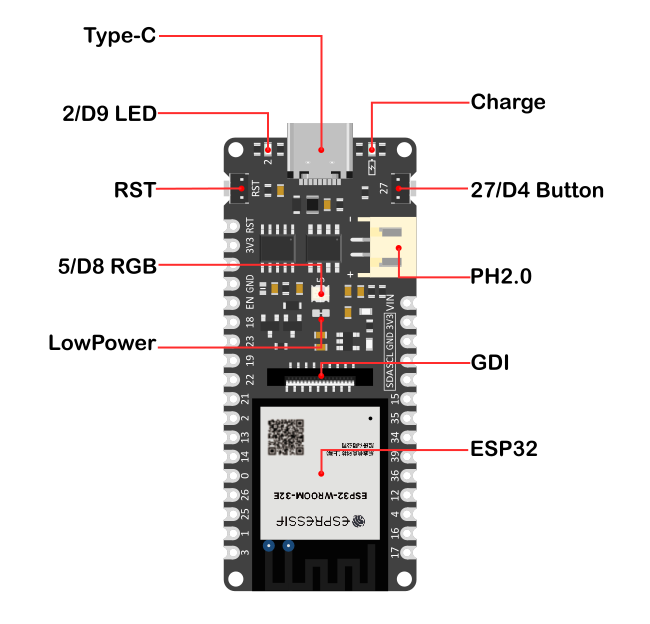You have chosen:[[togetherChouseinfo.num]]
Total amount: [[currency]][[togetherChouseinfo.price]] [[togetherChouseinfo.price]][[currency]]
You have chosen:[[togetherChouseinfo.num]]
Total amount: [[currency]][[togetherChouseinfo.price]] [[togetherChouseinfo.price]][[currency]]
FireBeetle 2 ESP32-E, specially designed for IoT, is an ESP-WROOM-32E-based main controller board with dual-core chips.
It supports WiFi and Bluetooth dual-mode communication and features a small size, ultra-low power consumption, on-board charging circuit, and easy-to-use interface, which can be conveniently used for smart home IoT, industrial IoT applications, and wearable devices, and so on. You can easily create your own IoT smart home system when connecting it with an IoT platform like IFTTT.
FireBeetle 2 ESP32-E supports Arduino programming and will support Scratch graphical programming and MicroPython programming very soon. We provide you with detailed online tutorials and application cases, and there are thousands of sensors with welding-free Gravity interfaces and actuators to help you get started easily. Besides, the stamp hole design makes it able to be easily embedded in your PCB, greatly saving your costs and time to build and test a prototype.
Note: FireBeetle 2 and FireBeetle pins and sizes are not compatible, and neither are the expansion boards.


Figure 2. Pinout
What's the difference between FireBeetle 2 ESP32-E and FireBeetle ESP32?
-ESP32-E uses a data encryption chip to protect program security
-ESP32-E is equipped with a DFRobot GDI(General Display Interface) to connect screens like DFR0664/DFR0649/DFR0665/DFR0669
-Software are ecologically compatible with both ESP32 and ESP32-E, except for minor changes in pin mapping
-ESP32-E cannot use an expansion board for ESP32 V4.0
|
SKU |
||
|
Microcontroller |
ESP32-D |
ESP32-E |
|
Power Supply Interface |
Micro USB |
USB-C |
|
USB to UART |
CH340C |
CH340K |
|
Operating Voltage (V) |
3.3V |
3.3V |
|
Flash |
16MB |
4MB |
|
SRAM (KB) |
520k |
520k |
|
Analog Pins |
5 |
5 |
|
Digital Pins |
10 |
10 |
|
UART |
1 |
1 |
|
I2C |
1 |
1 |
|
SPI |
1 |
1 |
|
Side Key |
× |
√ |
|
RGB_LED |
× |
√ |
|
DisplayPort (GDI) |
× |
√ |
|
Stamp Holes |
× |
√ |
|
Fool-proof |
× |
√ |
|
Silkscreen |
underside |
two-sided |
|
Mount Hole Size (mm) |
3.5 |
2 |
|
Dimension (mm) |
29*58 |
25.4*60 |
|
Weight (g) |
24 g |
23g |
Espressif has recently released one wafer-level change on the ESP32 Series of products: ESP32-E. Below are the main design changes in the ESP32-E Series of chips:
1. PSRAM Cache Bug Fix: Fixed “When the CPU accesses the external SRAM in a certain sequence, read & write errors can occur”.
2. Fixed “When each CPU reads certain different address spaces simultaneously, a read error can occur.”
3. Optimized 32.768 KHz crystal oscillator stability, the issue was reported by the client that there is a low probability that under ESP32-D hardware, the 32.768 kHz crystal oscillator couldn’t start properly.
4. Fixed Fault injection issues regarding secure boot and flash encryption are fixed.
5. Improvement: Changed the minimum baud rate supported by the CAN module from 25 kHz to 12.5 kHz.
1. Project: Make a Home-made Network Clock with ESP32-E
Introduction: This production will be very simple, getting the time from the internet via the wifi of the ESP32, and then you need to find a screen that displays the time. There are many options for the screen, LCD1602 or LED monochrome dot matrix for splicing. I accidentally saw a VFD fluorescent screen before, it was green-blue when it was lit, and it glowed with white light, which makes the whole screen a mottled beauty. So, I am going to use it here.
2. Project: Outdoor 3D Printed Wireless IoT Weather Station
Introduction: In this Instructable, we're going to be building an outdoor weather station that takes temperature, humidity, barometric pressure, light, and wind speed readings and posts them to the cloud to access through a Thingspeak dashboard.
3. Review: Review y testeo Firebeetle Esp32-E IoT (control led RGB con webserver) de DFRobot
Introduction: FireBeetle ESP32-E, especialmente diseñado para IoT , es una placa controladora principal basada en ESP-WROOM-32E con chips de doble núcleo.
4. Project: How UART Protocol Works - Gravity: UART Fiber Optic Transceiver Module
Introduction:
In this video, we will talk about the UART protocol. We're using Gravity: UART Fiber Optic Transceiver Module, which runs at 2000000 baud at any time within a distance of up to 10km, to make a weather station.
Make a Weather Station Using Environmental Sensor ►


